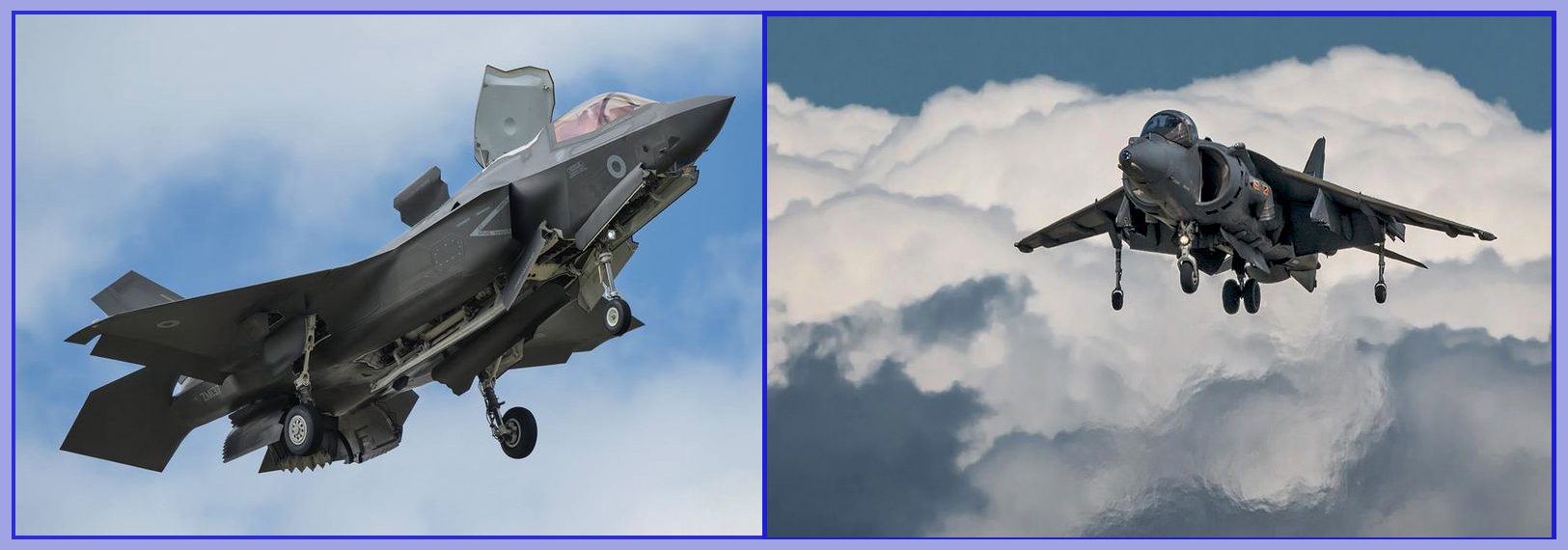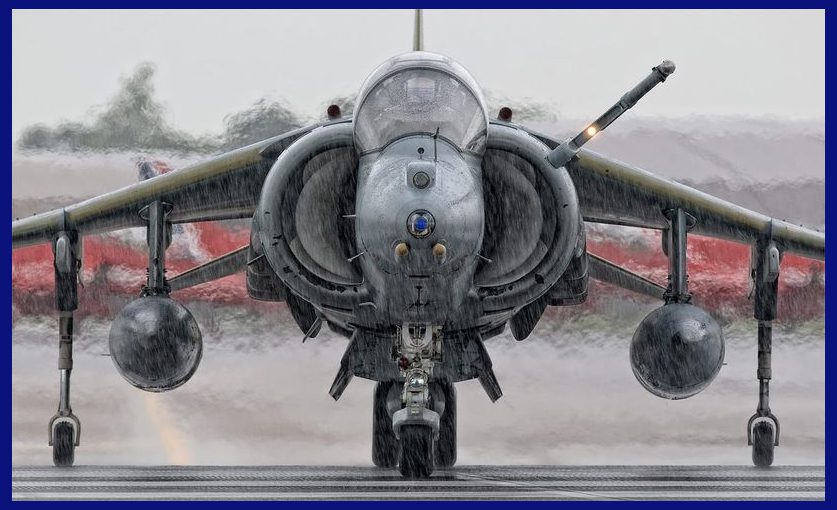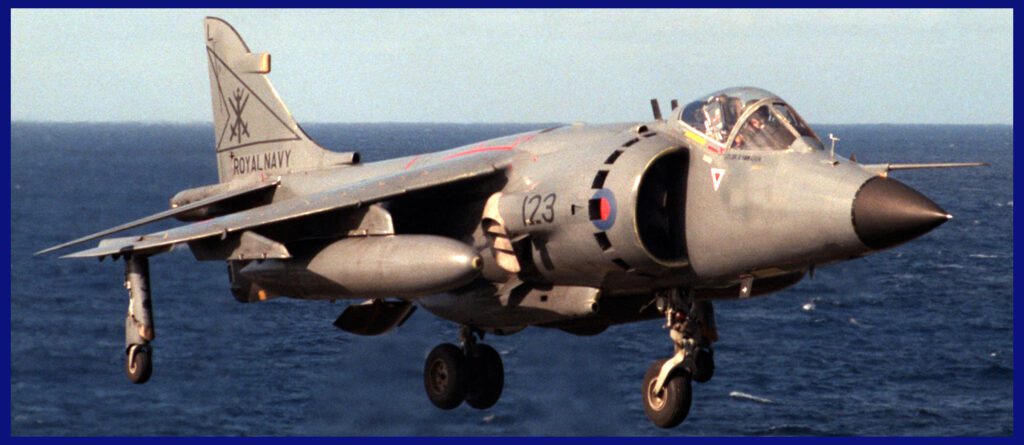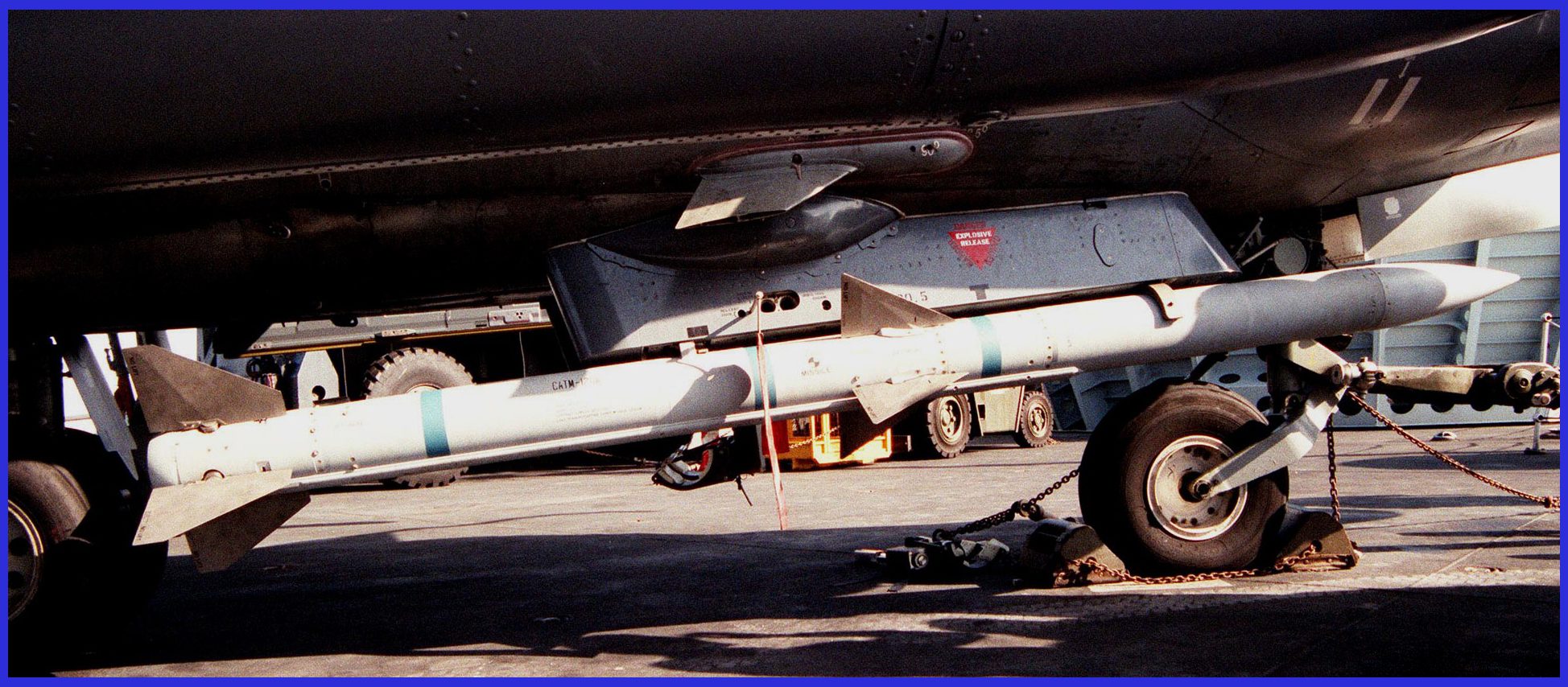
Propelled by a Rolls-Royce Pegasus turbofan engine, the Sea Harrier showcases remarkable agility and versatility, rendering it well-suited for both air defence and ground attack missions. Outfitted with missiles and a nose-mounted 30mm Aden cannon, the Sea Harrier played a pivotal role in historical conflicts, notably the Falklands War, where Sea Harrier squadrons successfully engaged and downed 20 Argentine aircraft in air-to-air combat without incurring any air-to-air losses. The Sea Harrier’s distinctive capabilities have solidified its status as a noteworthy and enduring asset in naval aviation, marked by an impeccable track record.

In April 1980, the Sea Harrier FRS1 was officially commissioned into the Royal Navy’s service. The primary role of the subsonic Sea Harrier was to safeguard the airspace above Royal Navy task groups centred around aircraft carriers. A subsequent and improved iteration tailored specifically for the Royal Navy, known as the Sea Harrier FA2, was developed in 1993.
The Sea Harrier was promoted for international sales, yet India stood as the sole country to incorporate it into their naval service. The aircraft was retired prematurely by the Royal Navy in 2006, although it remained on active duty with the Indian Navy for an additional decade before its eventual retirement in 2016. In essence, it emerged as one of the most successful aircraft, reshaping the outlook on V/STOL (Vertical/Short Takeoff and Landing) designs for the subsequent century.

The Background of the Sea Harrier
During the post-World War II period, requirements emerged within the Royal Navy for a vertical and/or short take-off and landing (V/STOL) carrier-based interceptor to replace the de Havilland Sea Vixen. The Sea Vixen’s significant deck space consumption, attributed to its wing span, prompted this need. Additionally, the Royal Navy aimed to construct medium-sized carriers capable of accommodating smaller jets in larger numbers.
The first V/STOL tests on a ship commenced with a Hawker Siddeley P.1127 aircraft, which first landed on HMS Ark Royal in 1963. Concurrently, upon their inaugural flights, a ski-jump was added to the end of the carrier deck, facilitating the effective operation of a small number of V/STOL jets.

The Hawker Siddeley Harrier GR1s of the Royal Air Force were introduced into service in April 1969. Subsequently, a specialized navalized version of the Harrier was developed by Hawker Siddeley for deployment on upcoming ships, leading to the creation of the Sea Harrier. In 1975, the Royal Navy placed an order for 24 Sea Harrier FRS.1 (Fighter, Reconnaissance, Strike) aircraft, which entered into service in 1978.
The operational status of the Sea Harrier was declared in 1981 aboard the first Invincible-class ship, HMS Invincible. Following the successful engagements in the Falklands War, further upgraded FA2 Harriers were introduced.

The BAe P.1184 Sea Harrier FRS.1 served as a dedicated carrier-based version of the RAF’s Harrier GR. Mk 3, specifically developed for the Royal Navy. Distinguishing features included a modified forward fuselage with an elevated cockpit canopy and a pointed radome housing the Blue Fox radar. The Harrier was additionally fitted with a 95.57-kN (21,490-lb st) Pegasus Mk 104 engine and underwent specific structural modifications to suit its naval role.
A total of 57 Harriers, including four two-seat Harrier T. Mk 4N trainers, were delivered to the Royal Navy. The Indian Navy procured 25 single-seat Sea Harrier FRS. Mk 51s and five two-seat Harrier T.Mk 60s for training purposes.

The Sea Harrier FRS. Mk 2 (later designated FA.Mk 2) represents an enhanced iteration of the earlier Harrier model, featuring the Blue Vixen radar housed in a sizable nose radome. It boasts improved systems, including a modernized cockpit, a lengthened rear fuselage, and a Pegasus Mk 106 engine. Notably, the radar stands out as one of the most capable fighter radars currently available, providing complete compatibility with AMRAAM missiles. The retirement of the Harrier took place in 2004-6, subsequently replaced by the GR. Mk9 in 2007. A total of 35 Harrier FRS. Mk 1s underwent modification to the FA.Mk 2 standard and an additional 18 new aircraft were constructed.

The Design of the Sea Harrier FA2
The Harrier is a subsonic aircraft designed for strike, reconnaissance, and interception missions. Featuring two intakes and four vectorable exhaust nozzles, it is equipped with a single Rolls-Royce Pegasus Mk 106 turbofan engine capable of generating a maximum thrust of 96 kN. Key design elements include:
Structural Enhancements: Structural modifications were implemented to accommodate the upgraded avionics and weapons systems while preserving the aircraft’s agility and V/STOL capabilities. The wings incorporate two outrigger landing gears, complemented by two landing gears on the fuselage. Additionally, three fuselage and four wing pylons were added to accommodate external fuel tanks and weaponry. The use of a ski jump enables the aircraft to take off from a short flight deck with a higher payload than would otherwise be conceivable. Additionally, it is capable of taking off like a regularly loaded fighter from a typical airport runway without the need for thrust vectoring nozzles.

Radar System: The FA2 was equipped with the Blue Vixen radar system, providing enhanced tracking and targeting capabilities. This radar facilitated improved detection and engagement of multiple targets simultaneously, thereby enhancing the aircraft’s air-to-air capabilities. Overall, it was described as one of the most advanced pulse Doppler radar systems globally. The Blue Vixen served as the foundation for today’s fourth-gen Eurofighter Typhoon‘s CAPTOR radar.
Avionics: Upgraded avionic systems, incorporating a radar warning receiver, were added in response to the threat of radar-based anti-aircraft weapons, and electronic countermeasures were also integrated. Other enhancements included an increased air-to-air weapons load, a look-down radar, extended range, and improved cockpit displays to enhance situational awareness and survivability in hostile environments.

Cockpit and Controls: The cockpit was upgraded with a “bubble” canopy for better visibility, along with modernized instruments and controls, providing the pilot with an improved interface and information display for enhanced mission management. Additionally, it features a conventional center-stick arrangement and a left-hand throttle. In addition to the standard flight controls, the Harrier is equipped with a lever to control the direction of the four vectorable nozzles.
Weapons Systems: The Sea Harrier FA2 was equipped with an upgraded weapons suite, incorporating the AIM-120 AMRAAM and AIM-9 Sidewinder air-to-air missiles. This extension of the aircraft’s engagement range and lethality against airborne threats was notable. After the Falklands War, the Sea Harrier underwent an enhancement with the addition of the Sea Eagle anti-ship missile.

The official approval for acquiring the Sea Harrier for the Indian Navy materialized in 1977. In November 1979, India placed an order for six Harrier FRS Mk 51 fighters and two T Mk 60 trainers. The initial three aircraft of this order landed at Dabolim Airport on December 16, 1983. Another ten were acquired in November 1985, eventually reaching a total procurement of 30 Harriers, with 25 designated for operational use and the remainder as dual-seat trainer aircraft. Up until the 1990s, a significant portion of pilot training took place in Britain due to limited aircraft availability.

The Harrier’s introduction allowed India to retire its previous carrier fighter, the Hawker Sea Hawk. Between 1987 and 1989, the aircraft carrier INS Vikrant also underwent a significant modernization program. On both the aircraft carriers INS Vikrant and INS Viraat, India has flown Harriers. This aircraft also made it possible to integrate several contemporary missiles into naval operations, including the French company Matra Magic air-to-air missile and the British-made Sea Eagle anti-ship missile. 68 mm rockets, runway-denial bombs, cluster bombs, and podded 30 mm cannons have all been used as other weaponry.

In 2006, the Indian Navy installed the Elta EL/M-2032 radar and the Rafael “Derby” medium-range air-to-air BVR missile on up to 15 Harriers. This enhancement extended the service capabilities of the Sea Harrier, enabling it to serve India beyond the year 2012.
A ceremony commemorating the phase-out of Sea Harriers from INAS 300 “White Tigers” took place at INS Hansa, Dabolim, Goa, on May 11, 2016. The Indian Harriers had faithfully served the Navy for 33 years before being replaced by the Russian MiG-29K fighters. Currently, the Indian Navy operates MiG-29K/KUB STOBAR fighters from INS Vikramaditya.

Sea Harrier FA.2 Specifications
- Type: Single-seat V/STOL tactical attack and reconnaissance aircraft
- Engine: one 21,500lb ( 9,752 kg ), 96 kN thrust, Rolls-Royce Pegasus 106 vectored-thrust turbofan
- Dimensions: Span: 25 ft 3in ( 7.6m )
- Length: 46 ft 6 in (14.17 m)
- Height: 12 ft 2 in (3.71 m)
- Wing area: 201.1 sq ft ( 18.68 m2 ).
- Weights: Empty 14,586 lb (6,616 kg) Max 26,000lb ( 11,793kg )
- Performance: ( GR.3 ) Maximum speed over 737 mph ( 1186 km/h, Mach 0.972 ) at a low level; Max dive Mach no. 1.3; Rate of climb 50,000ft/min (250 m/s); Max Service ceiling 51,000 ft (16,000 m); Tactical radius on strike mission without drop tank 418km (226 nmi), with Drop-tanks 740 km (400 nmi), Ferry range: 2,070 miles ( 3,331km )
- Armament: All external, with numerous options. Under-fuselage strakes, each replaceable by a pod containing two 30mm Aden cannons. The aircraft features five or seven stored towers, with the centre and two inboards rated at 2,000lb (907kg), outers at 650lb (295kg), and tips (if used) at 220lb (100kg) for Sidewinder AAM, initially fitted during the Falklands crisis
- The normal load capacity is 5,300lb (2,400kg), but it was tested and flown with a maximum capacity of 8,000lb (3,630kg). In overall design, the Harrier was capable of firing Sidewinder, AMRAAM, ALARM, Martel, Paveway LGB, Sea Eagle, Rocket launch pods, and unguided bombs

In conclusion, the British Aerospace Sea Harrier exemplifies the evolution of naval aviation, blending innovative design with advanced technology. Its V/STOL capabilities, complemented by upgrades like the Blue Vixen radar and modern avionics, position it as a formidable air defence platform. Vital to enhancing the Royal Navy and Indian Navy’s maritime prowess, the Sea Harrier FA2 demonstrated adaptability in modern warfare.
With its sleek design and potent weapons suite, it not only secured a place in aviation history but also left a lasting legacy as a versatile naval asset. Symbolizing engineering excellence, the Sea Harrier remains a testament to the successful fusion of agility, firepower, and adaptability in a naval fighter aircraft.

Important Announcement for Our Valued Readers!
After an article is published, it is possible that updates or changes may have occurred beyond the time of publication. Therefore, it is important to be aware that certain information in the article might be outdated. To ensure the most accurate analysis, it is highly recommended to verify the content with the latest sources available.
However, we are dedicated to delivering outstanding articles on military products and global updates. Maintaining quality and smooth operation requires resources. Your support sustains our efforts in providing insightful content. By purchasing high-quality products through our affiliated links, you help us keep our platform alive and acquire top-notch items. Your unwavering support is invaluable and inspires us to strive further.
We welcome your suggestions and requests for more information, as we value feedback from our readers. If there’s specific defence material or equipment not covered on our site, please share your request in the comments. We’ll strive to research and provide the required information. We sincerely thank you for your unwavering interest in our website, and we eagerly anticipate hearing from you! Enjoy your reading experience!
